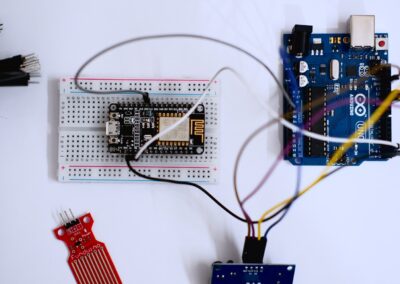Ensuring Security in IoT Firmware Updates
Implementing Robust Authentication Mechanisms
In the rapidly expanding Internet of Things (IoT) landscape, secure firmware updates for IoT devices are critical to maintaining device integrity and security. As the number of connected devices grows, particularly in advanced markets like Saudi Arabia and the UAE, ensuring that firmware updates are securely distributed and deployed becomes paramount. Implementing robust authentication mechanisms is a foundational step in securing these updates.
Authentication mechanisms ensure that only authorized entities can deploy firmware updates to IoT devices. This can be achieved through the use of digital signatures, which validate the authenticity of the firmware before it is installed. For instance, in smart city projects across Riyadh and Dubai, where IoT devices manage critical infrastructure such as traffic systems and public services, digital signatures help prevent unauthorized access and malicious updates.
Public key infrastructure (PKI) is another effective tool for securing firmware updates. By leveraging PKI, organizations can establish a framework for issuing, managing, and validating digital certificates. These certificates authenticate both the firmware and the entity deploying it, ensuring that updates come from a trusted source. This approach not only secures the update process but also builds trust with end-users, who can be confident that their devices are protected against tampering.
Ensuring End-to-End Encryption
Another essential best practice for secure firmware updates for IoT devices is the implementation of end-to-end encryption. Encryption protects the integrity and confidentiality of the firmware data as it is transmitted from the update server to the IoT device. This is particularly important in regions like the UAE and Saudi Arabia, where data security and privacy are heavily regulated.
End-to-end encryption ensures that even if the data is intercepted during transmission, it cannot be read or altered by unauthorized parties. For example, in Dubai’s ambitious IoT initiatives, which include smart transportation and energy management systems, encrypted firmware updates prevent cyber attackers from injecting malicious code or disrupting device operations. This not only protects the devices but also safeguards the overall infrastructure.
Additionally, organizations should employ secure transport protocols such as HTTPS and Transport Layer Security (TLS) to encrypt data in transit. These protocols provide a secure communication channel between the update server and the IoT device, further enhancing the security of the firmware update process. By prioritizing encryption, businesses can mitigate the risk of data breaches and ensure the safe deployment of firmware updates.
Conducting Regular Security Audits and Penetration Testing
Regular security audits and penetration testing are crucial for maintaining the security of the firmware update process. These practices involve systematically reviewing and testing the IoT ecosystem to identify and address potential vulnerabilities. In the context of IoT deployments in Riyadh and other parts of Saudi Arabia, where the digital landscape is continuously evolving, regular audits ensure that security measures remain effective against emerging threats.
Security audits involve a thorough examination of the update infrastructure, including the servers, networks, and devices involved in the update process. This helps identify weaknesses that could be exploited by attackers. Penetration testing, on the other hand, simulates cyberattacks on the system to uncover vulnerabilities and test the resilience of security controls. By regularly conducting these assessments, organizations can proactively address security gaps and enhance the overall robustness of their IoT deployments.
Furthermore, engaging third-party security experts to perform independent audits and tests can provide an unbiased evaluation of the system’s security. This external perspective is valuable for uncovering issues that internal teams might overlook. By incorporating regular security audits and penetration testing into their security strategy, organizations can ensure that their firmware update process remains secure and resilient against potential threats.
Implementing Efficient Deployment Strategies
Adopting Over-the-Air (OTA) Update Mechanisms
Over-the-air (OTA) update mechanisms are an efficient and effective way to distribute firmware updates to IoT devices. OTA updates enable organizations to deploy updates wirelessly, eliminating the need for physical access to each device. This is particularly advantageous in large-scale IoT deployments, such as those in smart cities like Dubai, where manually updating each device would be impractical and time-consuming.
OTA updates provide a seamless and user-friendly experience, allowing updates to be deployed automatically without interrupting device operation. This ensures that devices always operate with the latest firmware, improving functionality and security. Additionally, OTA mechanisms can be combined with secure boot processes, which verify the integrity of the firmware before allowing it to run. This prevents devices from booting with compromised firmware, enhancing the overall security of the IoT ecosystem.
To implement OTA updates securely, organizations should use encrypted communication channels and ensure that update packages are digitally signed. This prevents tampering during transmission and ensures that only authenticated updates are installed on the devices. By adopting OTA update mechanisms, businesses can streamline the firmware update process, reduce operational costs, and enhance the security and reliability of their IoT deployments.
Implementing Staged Rollouts and Rollback Mechanisms
Staged rollouts and rollback mechanisms are essential strategies for managing firmware updates in IoT deployments. Staged rollouts involve deploying updates to a small subset of devices before a full-scale rollout. This allows organizations to monitor the update’s performance and identify any issues before they affect the entire device network. In Saudi Arabia’s smart city projects, for example, staged rollouts can help ensure that updates to traffic management systems do not disrupt city-wide operations.
By gradually increasing the number of devices receiving the update, organizations can mitigate the risk of widespread issues and gather valuable feedback to improve the update process. If any problems are detected, rollback mechanisms allow organizations to revert the devices to the previous firmware version quickly. This ensures that any disruptions are minimized, and devices can continue operating without prolonged downtime.
Rollback mechanisms are particularly crucial in environments where IoT devices play a critical role in public safety and infrastructure. In Dubai’s smart city initiatives, where IoT devices manage essential services, the ability to quickly revert to a stable firmware version is vital for maintaining operational continuity. By implementing staged rollouts and rollback mechanisms, organizations can ensure a smooth and secure update process, minimizing the impact of potential issues.
Ensuring Comprehensive Device Monitoring and Management
Effective device monitoring and management are critical components of a secure firmware update strategy. Continuous monitoring allows organizations to track the status of devices, detect anomalies, and ensure that updates are applied correctly. In regions like the UAE and Saudi Arabia, where regulatory compliance is essential, comprehensive monitoring provides the transparency and accountability needed to meet regulatory standards.
IoT device management platforms offer centralized control and visibility over the entire device fleet, enabling organizations to monitor device health, performance, and update status in real-time. These platforms can generate alerts for any issues that arise during the update process, allowing for prompt resolution. In addition, integrating monitoring with security information and event management (SIEM) systems enhances the ability to detect and respond to security incidents.
Furthermore, device management platforms can automate routine tasks such as firmware updates, reducing the operational burden on IT teams. By ensuring that devices are continuously monitored and managed, organizations can maintain the security and reliability of their IoT deployments, supporting long-term success and compliance.
In conclusion, secure firmware updates for IoT devices are essential for maintaining device security, functionality, and regulatory compliance. By implementing robust authentication mechanisms, ensuring end-to-end encryption, conducting regular security audits, adopting OTA update mechanisms, implementing staged rollouts and rollback mechanisms, and ensuring comprehensive device monitoring and management, organizations in Saudi Arabia, the UAE, and beyond can effectively secure their IoT ecosystems. These best practices not only protect against emerging threats but also enhance the overall resilience and performance of IoT deployments, driving innovation and business success.
—
#SecureFirmwareUpdatesForIoTDevices #IoTSecurity #FirmwareDeployment #IoTBestPractices #SaudiArabia #UAE #Riyadh #Dubai #ModernTechnology
































